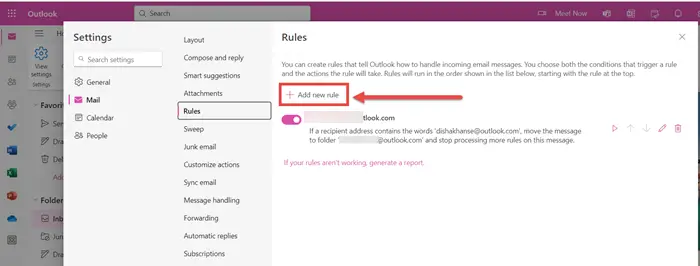Yes, email is the most widely used service on the Internet, and the commonly used transmission protocol is "SMTP". The SMTP protocol belongs to the TCP/IP protocol suite, which helps each computer find the next destination when sending or relaying letters.

The operating environment of this tutorial: Windows 7 system, Dell G3 computer.
E-mail is the most widely used service on the Internet, and the commonly used transmission protocol is "SMTP".
SMTP is a protocol that provides reliable and efficient email transmission. SMTP is an email service built on the FTP file transfer service. It is mainly used to transfer email information between systems and provide notifications about incoming letters. SMTP is independent of a specific transmission subsystem and only requires the support of a reliable and orderly data flow channel. One of the important features of SMTP is its ability to transmit emails across the network, that is, "SMTP mail relay". Using SMTP, mail transmission can be realized between processing processes on the same network, and mail transmission between a processing process and other networks can also be realized through a relay or gateway.
The working process of the SMTP protocol can be divided into the following three processes:
(1) Establish a connection: At this stage, the SMTP client requests port 25 of the server Establish a TCP connection. Once the connection is established, the SMTP server and client begin to advertise their domain names to each other and confirm each other's domain names.
(2) Mail transmission: Using commands, the SMTP client passes the source address, destination address and specific content of the mail to the SMTP server, and the SMTP server responds accordingly and receives the mail.
(3) Connection release: The SMTP client issues an exit command, the server responds after processing the command, and then closes the TCP connection.
For more related knowledge, please visit the FAQ column!
The above is the detailed content of Is email the most widely used service on the internet?. For more information, please follow other related articles on the PHP Chinese website!
 如何在Outlook中按发件人、主题、日期、类别、大小对电子邮件进行排序Feb 19, 2024 am 10:48 AM
如何在Outlook中按发件人、主题、日期、类别、大小对电子邮件进行排序Feb 19, 2024 am 10:48 AMOutlook提供了许多设置和功能,可帮助您更有效地管理工作。其中之一是排序选项,可让您根据需要对电子邮件进行分类。在这个教程中,我们将学习如何利用Outlook的排序功能,根据发件人、主题、日期、类别或大小等条件对电子邮件进行整理。这将让您更轻松地处理和查找重要信息,提高工作效率。MicrosoftOutlook是一个功能强大的应用程序,可以方便地集中管理您的电子邮件和日历安排。您可以轻松地发送、接收和组织电子邮件,而内置的日历功能也让您能够方便地跟踪您即将面临的活动和约会。如何在Outloo
 当您在 iPhone 上使用“隐藏我的电子邮件”时会发生什么?Feb 22, 2024 pm 09:19 PM
当您在 iPhone 上使用“隐藏我的电子邮件”时会发生什么?Feb 22, 2024 pm 09:19 PMApple提供了一个名为“隐藏邮件地址”的重视隐私的功能,允许用户在需要注册账户的应用程序或网站上隐藏其真实电子邮件地址。我们已经教您如何在iPhone上使用此功能,现在让我们一起看看在日常工作中使用它时可能发生的情况。什么是iPhone上的隐藏邮件地址?“隐藏邮件地址”功能的目的是为了保护您的电子邮件地址隐私。通过为应用程序和网站注册提供临时电子邮件地址的方式,您无需直接提供个人的真实电子邮件地址。这个功能允许您生成多个iCloud电子邮件地址,用于注册不同的服务,从而避免泄露真实的电子邮件地
 什么是公网ipSep 27, 2021 am 10:30 AM
什么是公网ipSep 27, 2021 am 10:30 AM公网ip是指用公网连接Internet上的非保留地址,可以与Internet上的其他计算机随意互相访问。互联网上的每台计算机都有一个独立的IP地址,该IP地址唯一确定互联网上的一台计算机,这个IP地址就是指的公网IP地址。
 如何利用C++实现一个简单的电子邮件发送程序?Nov 02, 2023 pm 05:35 PM
如何利用C++实现一个简单的电子邮件发送程序?Nov 02, 2023 pm 05:35 PM如何利用C++实现一个简单的电子邮件发送程序?随着互联网的普及,电子邮件已经成为人们日常生活和工作中不可或缺的一部分。在C++编程中,我们可以利用SMTP(SimpleMailTransferProtocol)协议实现一个简单的电子邮件发送程序。本文将介绍如何使用C++编写一个基本的电子邮件发送程序。首先,我们需要准备一些工具和库来实现我们的程序。首先
 如何使用Flask-Mail发送电子邮件Aug 02, 2023 am 10:17 AM
如何使用Flask-Mail发送电子邮件Aug 02, 2023 am 10:17 AM如何使用Flask-Mail发送电子邮件随着互联网的发展,电子邮件已经成为了人们沟通的重要工具。在开发Web应用中,有时候我们需要在特定的场景下发送电子邮件,比如用户注册成功后发送欢迎邮件,或者用户忘记密码时发送重置密码邮件等。Flask是一款简单而又灵活的PythonWeb框架,而Flask-Mail是Flask框架下用于发送邮件的扩展库,本文将介绍如何
 internet的通信协议是什么?Dec 24, 2020 pm 02:53 PM
internet的通信协议是什么?Dec 24, 2020 pm 02:53 PMInternet采用的主要通信协议是“TCP/IP协议”,TCP/IP传输协议,即传输控制/网络协议,也叫作网络通讯协议;它是在网络的使用中的最基本的通信协议,TCP/IP传输协议对互联网中各部分进行通信的标准和方法进行了规定。
 电子邮件的特点是什么Jan 22, 2021 pm 04:10 PM
电子邮件的特点是什么Jan 22, 2021 pm 04:10 PM电子邮件的特点是:1、成本低廉,电子邮件采用存储转发方式在网络上逐步传递信息,不像电话那样直接,但费用较低;2、传播速度快,电子邮件综合了电话通信和邮政信件的特点,它传送信息的速度和电话一样快,几秒钟之内可以发送到世界上任何指定的目的地;3、非常便捷;4、广泛的交流对象,可与世界上任何一个角落的网络用户联系;5、信息多样化,可以是文字、图像、声音等多种形式;6、比较安全。
 PHP电子邮件模板:定制化和个性化您的邮件内容。Sep 19, 2023 pm 01:21 PM
PHP电子邮件模板:定制化和个性化您的邮件内容。Sep 19, 2023 pm 01:21 PMPHP电子邮件模板:定制化和个性化您的邮件内容随着电子邮件的普及和广泛应用,传统的邮件模板已经不能满足人们对个性化和定制化邮件内容的需求。现在,我们可以通过使用PHP编程语言来创建定制化和个性化的电子邮件模板。本文将为您介绍如何使用PHP来实现这一目标,并提供一些具体的代码示例。一、创建邮件模板首先,我们需要创建一个基本的邮件模板。这个模板可以是一个HTM

Hot AI Tools

Undresser.AI Undress
AI-powered app for creating realistic nude photos

AI Clothes Remover
Online AI tool for removing clothes from photos.

Undress AI Tool
Undress images for free

Clothoff.io
AI clothes remover

AI Hentai Generator
Generate AI Hentai for free.

Hot Article

Hot Tools

SublimeText3 Mac version
God-level code editing software (SublimeText3)

MantisBT
Mantis is an easy-to-deploy web-based defect tracking tool designed to aid in product defect tracking. It requires PHP, MySQL and a web server. Check out our demo and hosting services.

MinGW - Minimalist GNU for Windows
This project is in the process of being migrated to osdn.net/projects/mingw, you can continue to follow us there. MinGW: A native Windows port of the GNU Compiler Collection (GCC), freely distributable import libraries and header files for building native Windows applications; includes extensions to the MSVC runtime to support C99 functionality. All MinGW software can run on 64-bit Windows platforms.

WebStorm Mac version
Useful JavaScript development tools

Safe Exam Browser
Safe Exam Browser is a secure browser environment for taking online exams securely. This software turns any computer into a secure workstation. It controls access to any utility and prevents students from using unauthorized resources.






